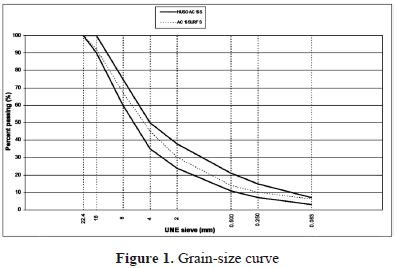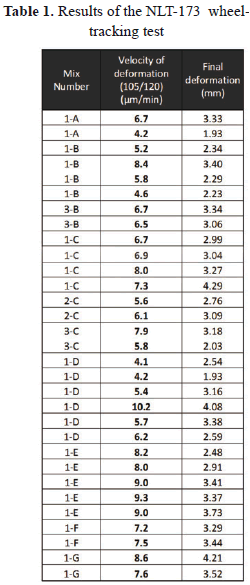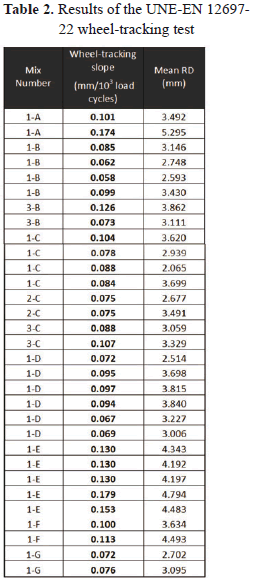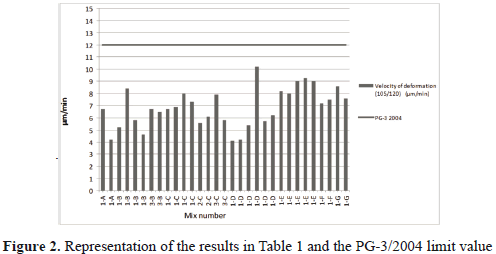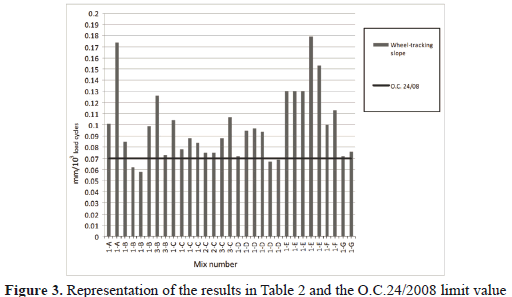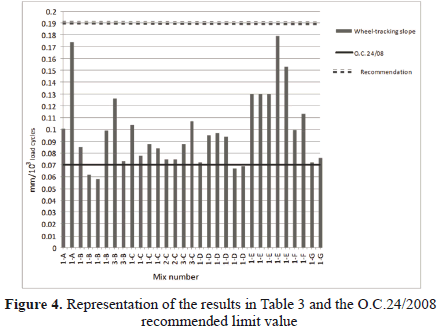Serviços Personalizados
Journal
Artigo
Indicadores
-
 Citado por SciELO
Citado por SciELO -
 Acessos
Acessos
Links relacionados
-
 Citado por Google
Citado por Google -
 Similares em
SciELO
Similares em
SciELO -
 Similares em Google
Similares em Google
Compartilhar
DYNA
versão impressa ISSN 0012-7353
Dyna rev.fac.nac.minas vol.79 no.174 Medellín jul./ago. 2012
BITUMINOUS MIX RESPONSE TO PLASTIC DEFORMATIONS: COMPARISON OF THE SPANISH NLT-173 AND UNE-EN 12697-22 WHEEL-TRACKING TESTS
ANÁLISIS COMPARATIVO DEL COMPORTAMIENTO DE UNA MEZCLA BITUMINOSA FRENTE A DEFORMACIONES PLÁSTICAS, ATENDIENDO A LOS ENSAYOS NLT / UNE-EN
GEMA GARCÍA-TRAVÉ
Degree in Chemistry. Universidad de Granada, gemamgt@correo.ugr.es
MARIA JOSÉ MARTINEZ-ECHEVARRIA
Civil Engineer. Universidad de Granada, mjmartinezechevarria@ugr.es
MARÍA DEL CARMEN RUBIO GÁMEZ
PhD. Universidad de Granada, mcrubio@ugr.es
FERNANDO MORENO NAVARRO
Civil Engineer. Universidad de Granada, fmoreno@ugr.es
Received for review February 2th, 2012, accepted March 9th, 2012, final version March, 21th, 2012
ABSTRACT: Rutting severely damages flexible pavements. It causes the loss of road surface regularity, which evidently has a negative impact on the quality of service to users. Of the various kinds of laboratory test used to assess plastic deformations in pavement layers, simulation tests are extremely important. The objective of this research study was to evaluate and determine the differences between the wheel-tracking test when performed in the laboratory, according to the Spanish NLT-173 regulations and the wheel-tracking test when performed according to UNE-EN 12697-22 regulations. When the CE marking for bituminous mixes was established in 2008, this test became mandatory. Results show that reference values required in the PG-3/2004 Spanish regulation should be modified.
KEY WORDS: Plastic deformations, Bituminous mix, Wheel-tracking test
RESUMEN: La formación de roderas es uno de los mayores deterioros que se producen en los firmes flexibles, lo que ocasiona la pérdida de regularidad superficial que repercute de forma negativa en la calidad del servicio prestado a los usuarios. Existen distintos ensayos de laboratorio que permiten evaluar las deformaciones plásticas producidas en las capas del pavimento, entre ellos podemos destacar los ensayos de simulación. El objetivo de esta investigación es analizar el comportamiento de una mezcla bituminosa en caliente frente a deformaciones plásticas, mediante dos métodos de ensayo diferentes; ensayo en pista de laboratorio de acuerdo a la normativa española NLT-173 y el ensayo de rodadura UNE-EN 12697-22 (ensayo obligatorio tras la entrada en vigor del Marcado CE de mezclas bituminosas en 2008). La finalidad última de este artículo es formular una propuesta de modificación de la normativa española (PG-3) sobre los límites exigibles en éste último ensayo.
PALABRAS CLAVE: Deformaciones plásticas, Mezcla bituminosa, Ensayo de rodadura, Ensayo en pista
1. INTRODUCTION
Rutting is one of the most frequent types of damage found in pavement surface layers. In fact, it is considered to be one of the most serious deformations that affect the performance of hot bituminous mixes. Rutting stems from the accumulation of plastic deformations due to mechanical loads from vehicle traffic, especially heavy vehicles traveling at low speeds and in high temperatures. Since the viscoelastoplastic behavior of bituminous mixes is extremely sensitive to such conditions [1,2], permanent pavement deformations often develop, appearing in the form of longitudinal depressions in the wheelpaths accompanied by small upheavals to the sides [3]. The accumulation of plastic deformations can be caused by the combination of volumetric reduction of mix material and shear strain from traffic loads [4]. This leads to the subsequent loss of road surface regularity, which has a negative impact on the quality of service to users.
Factors affecting or intervening in the formation of pavement ruts are related to mix design as well as to mix components. These include but are not limited to the mineral skeleton [1,5,6]; aggregate [7,8]; and type and percentage of binder in the mix [3,9,10]. This type of plastic deformation is evaluated in the laboratory by simulation tests such as the asphalt pavement analyzer (APA), the Hamburg wheel-tracking test, and the French rutting tester (FRT), etc. [11–13].
Until the CE marking for hot bituminous mixes went into force, the most frequent test used in Spain was the wheel-tracking test, as characterized in the NLT-173/00 regulations [14]. This was subsequently replaced by the UNE-EN 12697-22 [15] version of the wheel-tracking test, which included different specifications. Since bituminous mixes had to be evaluated with a new set of tests, this made it necessary to modify official technical requirements and to revise articles 542 and 543 of the Pliego de Prescripciones Técnicas Generales para Obras de Carreteras y Puentes (General and Technical Specifications for Road and Bridge Construction) [16].
Because of this new situation, certain mixes that had originally fulfilled the PG-3 requirements [17] for NLT tests, previous to the enactment of the CE marking, are no longer in compliance with the requirements specified in the UNE-EN tests. In other words, mixes that were considered apt for use in road construction before March 2008 are no longer so, according to the new regulations.
This article presents the results obtained when these two pavement-testing methods were applied to a set of identical samples made with the same mix. The objective of this research was to evaluate and compare both tests in the context of the NLT and UNE-EN standards and verify the degree of equivalence or correspondence of the specification limits in both sets of regulations.
2. EXPERIMENTAL DESIGN
2.1. Materials
The aggregates used in the study were ophite and fine aggregate with limestone filler. The bitumen was standard bitumen 35/50 penetration grade.
2.2. Mix definition
Asphalt concrete is one of the mixes most often used in road construction in Europe. The mix used in this research was AC 16 Surf 35/50 [16,18]. Based on the grain-size fractions of the different aggregates, the grain-size curve was fit to the specifications in the PG-3 regulations [16] (see Fig. 1). The optimal bitumen content (4.58% of the total mix weight) was obtained with the Marshall test (NLT-159/00) [14].
3. METHODOLOGY
This research compared the UNE-EN 12697-22 [15] and NLT-173/00 [14] wheel-tracking tests for hot bituminous mix specification. The ultimate purpose of this study was to provide recommendations concerning the technical requirements for hot bituminous mixes according to the UNE-EN 12697-22 standard and correlate them with specifications in the NLT-173/00 regulations.
In statistics, the extraction of scientifically valid conclusions for a population, based on sampling results, presupposes the assumption of normality, and this means that the sample data must be checked for compliance with this assumption. This can be done by using the central limit theorem, which guarantees that the distribution of sample data will be normal when the size of the sample is sufficiently large (greater than 30) [19]. Based on this premise, 33 samples were tested between 2009 and 2010, all of which were of the same type, AC 16 Surf 35/50 S.
These samples were labeled with their mixing and manufacturing date. They were characterized both at the site and in the Construction Engineering Laboratory at the University of Granada. Each of the samples was subjected to both the NLT-173/00 [14] and UNE-EN 12697-22 [15] wheel-tracking tests.
In Spain, one of the laboratory procedures used to measure a mix's resistance to plastic deformation is the ensayo en pista de laboratorio [wheel-tracking test], described in the Spanish Technical NLT Standards [14], Road Tests of the Centro de Estudio de Carreteras (Road Study Center). As part of this test, a vibratory compactor is used to manufacture three prismatic test specimens (300x300x50 mm), whose height varies, depending on maximum aggregate size.
For dense and semi-dense mixes, the quantity of mix used in the test specimen is calculated by taking at least 97% of the density of the corresponding Marshall design. In the other mixes, 95% of the density is taken. The specimens are pre-heated in an oven at a temperature of (60±2) ºC for at least 4 h before the test is carried out. The specimens are then subjected to repeated passes of a loaded wheel. During the test, the contact pressure of the wheel on the surface of the sample is 900 KN at a frequency of 21 cycles/minute.
Periodic measurements of deformation depth are made during a period of 120 min or until the total deformation reaches 15 mm. The plastic deformation of the mix is based on the mean velocity of deformation in a time interval of 120/105 min:

where d120 and d105 are deformations at 120 and 105 min, respectively.
In contrast, the UNE-EN 12697-22 [15] ensayo de rodadura (wheel-tracking test) involves the manufacture of 2 parallelepiped test specimens with a roller compactor [20]. The specimens have a minimum density of 98% of the Marshall density. The height of the specimens varies, depending on maximum aggregate size. Before the test, the specimens are pre-heated at a temperature of 60 ºC [16]. Although the European standard specifies 3 types of wheel device, Spain uses the smallest one, namely, Procedure B [16].
This device consists of a loaded wheel that repeatedly passes over the test specimen. The load applied is 700 N at a frequency of 26.5±1.0 load cycles/minute. Another mechanism measures the speed at which the rut forms on the surface of the specimen. The test ends after 10,000 passes of the loaded wheel or until the deformation depth reaches 20 mm. The deformation slope is determined based on the rut depth between 5,000 and 10,000 cycles.

The results obtained are shown in Tables 1 and 2.
The data in Tables 1 and 2 were statistically analyzed, and a linear regression model was calculated based on the NLT and UNE-EN test results. However, this model was not valid since the determination coefficient (R2) was low. The Kolmogorov-Smirnov test was then applied to a sample in order to determine the goodness-of-fit of the variables to a certain theoretical probability distribution. In this case, both were found to fit the normal distribution.
Once the normality of the samples was determined, it was necessary to verify whether there was a statistically significant difference between the distributions of the two variables under consideration. For this purpose, the t-test was performed on the two independent samples. This was done to see whether the populational mean values of the two normal and independent populations were equal. Finally, the variables were typified and the values of the UNE-EN variable were determined, based on the values of the NLT variable. The Statistical Package for the Social Sciences (SPSS) computer application was the instrument used for this purpose.
4. RESULTS AND DISCUSSION
In this study, the most restrictive PG-3 requirements were used for the NLT-173/00 wheel-tracking test as well as the UNE-EN 12697-22 wheel-tracking test; namely, 12 mm/min and 0.07 mm/103 load cycles, respectively. Figures 2 and 3 show the results obtained for each of these tests and the corresponding limit value.
All of the values obtained in the NLT wheel-tracking test (see Fig. 2) meet the limit value in the PG-3 requirements for this test. In contrast, only 4 of the samples tested meet the O.C. 24/2008 requirements for the UNE-EN plastic deformation test. This shows that European requirements are much more restrictive than the NLT-173/00 specifications for the wheel-tracking test.
The results obtained in this study were statistically analyzed with a view to discovering whether NLT limit values were equivalent to those in the UNE-EN requirements. For this purpose, a regression analysis was performed, namely, Linear Model Y = a + b X, considering the independent variable Y (UNE-EN 12697-22 plastic deformation test), and the independent variable X (NLT-173/00 wheel-tracking test). The results showed that there was no statistically significant relation between the NLT-173/00 wheel-tracking test and the UNE-EN 12697-22 wheel-tracking test for a 95% confidence level. Moreover, the determination coefficient value was low (5.6%). Therefore, this method was not viable for our purposes. However, it was possible to verify the normality of the variables with the Kolmogorov-Simirnov test (see Table 3).
Based on the p-value or empirical significance level of the Kolmogorov-Smirnov test for both variables (0.528 and 0.999, respectively) for these sample data, the variables appear to have a normal distribution. Nevertheless, to verify if this was indeed the case, the T-test for equality of means was applied (see Table 4).
Based on the p-value (Sig.) of the Levene test for equality of variances, and given the fact that the p-value is less than 0.05, there is a statistically significant difference between the two variances for a confidence level of 95.0%. As shown in Table 4, there is a statistically significant difference between the means of the populations for the 2 samples giving us a 95% confidence level. Therefore, even though the distributions of the 2 variables are normal, they do not have the same distribution since neither their means nor their variances coincide.
The values of the UNE-EN 12697-22 wheel-tracking test variable were determined on the basis of the values of the NLT-173/00 wheel-tracking test variable. This was done by typifying the variables of the UNE-EN test and NLT test. The typified 12 mm/min value of the NLT test variable was 3.2184, and the value of the typified UNE-EN test variable was the same. The value thus obtained was 0.19 mm/103 load cycles (see Fig. 4).
As can be observed in Fig. 4, the results of all samples tested by the UNE-EN 12697-22 wheel-tracking test are less than 0.19 mm/103 load cycles, the same as those of all samples tested by the NLT-173/00 wheel-tracking test. All of them are in compliance with the PG-3/2004 specifications.
5. CONCLUSIONS
Based on the results obtained in this research for the AC 16 Surf 35/50 S mix, the following conclusions can be derived:
In reference to specifications required to evaluate the resistance of a bituminous mix to plastic deformations, the OC 24/2008 (UNE-EN 12697-22 wheel-tracking test) is more restrictive than the PG3/2004 (NLT-173/00 wheel-tracking test). In other words, before the regulations were changed when the CE marking went into force, all of the mixes tested in this study met the PG3 requirements and thus were considered apt for use in road construction. However, now these same mixes are not in compliance with regulations.
Based on the results obtained for the AC16Surf 35/50 S mix, the test variables were typified. It was found that for a value of 12 mm/min for the NLT wheel-tracking test, a value of 0.19 mm/103 load cycles was obtained for the UNE-EN 12697-22 test. Consequently, our study shows that 0.19 mm/103 load cycles is the value that should be required in the UNE-EN test since it corresponds to the 12 mm/min, previously required in the PG-3/2004 regulations.
ACKNOWLEDGEMENTS
This research has been funded by the following companies and organizations: Aldesa; Eiffage Infraestructuras; Agencia Andaluza de Obras Públicas; Martín Casillas, Ploder, Sacyr and Vera.
REFERENCES
[1] Suo, Z., Wong, W. G., Nonlinear properties analysis on rutting behaviour of bituminous materials with different air void contents. Construction and Building Materials, Vol.23(12), pp. 3492-3498, 2009. [ Links ]
[2] Young, S., Kyoug, K., Serji, N.A., Kwangw, K., Framework for developing a static strength test for measuring deformation resistance of asphalt concrete mixtures. Construction and Building Materials, Vol. 21, (12) pp. 2047-2058, 2007. [ Links ]
[3] Fontes, L., Trichês, G., Pais, J. C., Pereira, P. A.A., Evaluating permanent deformation in asphalt rubber mixtures. Construction and Building Materials, Vol. 24, (7) pp. 1193-1200, 2010. [ Links ]
[4] Reyes-Ortiz, O.J., Alvarez-Lugo, A.E., Botella-Nieto, R., Study of a hot asphalt mixture response based on energy concepts. Dyna, Vol. 78, N. 168, pp. 45-52, 2011. [ Links ]
[5] Pei-long, L., Zheng-qi, Z., Bing-gang, W., Permanent Deformation behaviour of composites structure Asphalt Concrete. Applied Mechanics and Materials, Vols. 34-35, pp. 1477-1482, 2010. [ Links ]
[6] Zakaria, M., Leest, G., Rutting characteristics of unbound aggregate layers. Construction and Building Materials, Vol.10 (3), pp. 185-189, 1996. [ Links ]
[7] Huang, B., Chen, X., Sun, X., Masad, E., Mahmoud, E., Effects of coarse aggregate angularity and asphalt binder on laboratory-measuredpermanent deformation properties of HMA. International Journal of Pavement Engineering, Vol. 10 (1) pp.19-28, 2009. [ Links ]
[8] Topal, A., Sengoz, B., Evaluation of compacted aggregate resistant test compared with the fine aggregate angularity standards. Construction and Building Materials, Vol.22 (5), pp. 993-998, 2008. [ Links ]
[9] Lu, X., Redelius, P., Effect of bitumen wax on asphalt mixture performance. Construction and Building Materials, Vol.21, Issue 11, pp. 1961-1970, 2007. [ Links ]
[10] Morea, F., Agnusdei, J.O., Zerbino, R., The use of asphalt low shear viscosity to predict permanent deformation performance of asphalt concrete. Materials and Structures, Article in Press. Doi:10.1617/s11527-010-9696-3. [ Links ]
[11] Williams, R. C., Prowell, B. D., Comparison of Laboratory Wheel-Tracking test results with Westrack Performance. Transportation Research Record 1681, N. 99-1457, pp. 121-128, 1999. [ Links ]
[12] Perraton, D., Di Benedetto, H., Sauzéat, C., De La Roche, C., Bankowski, W., Partl, M., Grenfell, J., Rutting of bituminous mixtures: wheel tracking tests campaign analysis. Materials and Structures, Article in Press. doi:10.1617/s11527-010-9680-y. [ Links ]
[13] Zhou, F., Chen, Dar-Hao, Scullion, T., Bilyeu, J., Case study: Evaluation of laboratory test methods to characterize permanent deformation properties of asphalt mixes. International Journal of Pavement Engineering, Vol. 4 (3), pp.155-164, 2003. [ Links ]
[14] Dirección General de Carreteras: Normas NLT I. Ensayos de carreteras. Ministerio de Obras Públicas y Transportes (MOPT), N2, 1ª Edición, Anejo septiembre 2000. [ Links ]
[15] UNE-EN 12697-22:2008+A1:2008: Mezclas bituminosas. Método de ensayo para mezclas bituminosas en caliente. Parte 22: Ensayo de rodadura. AENOR 2008. [ Links ]
[16] Orden Circular 24/2008 sobre el Pliego de Prescripciones Técnicas Generales para Obras de Carreteras y Puentes (PG-3): Artículos: 542- Mezclas bituminosas en caliente tipo hormigón bituminoso y 543- Mezclas bituminosas para capas de rodadura. Mezclas drenantes y discontinuas. Ministerio de Fomento. Madrid, July 2008. [ Links ]
[17] Pliego de Prescripciones Técnicas Generales para Obras de Carreteras y Puentes (PG-3). 4ª Edición. Ediciones Liteam, 2004. [ Links ]
[18] UNE-EN 13108-1: 2008. Mezclas bituminosas. Especificaciones de materiales. Parte 1: Hormigón asfáltico. AENOR 2008. [ Links ]
[19] Peña, D. Estadística 1: Fundamentos. Editorial Universidad Textos. 1994. [ Links ]
[20] UNE-EN 12697-33:2006+A1:2007. Mezclas bituminosas. Método de ensayo para mezclas bituminosas en caliente. Parte 33: Elaboración de probetas con compactador de placa. AENOR 2007 [ Links ]













